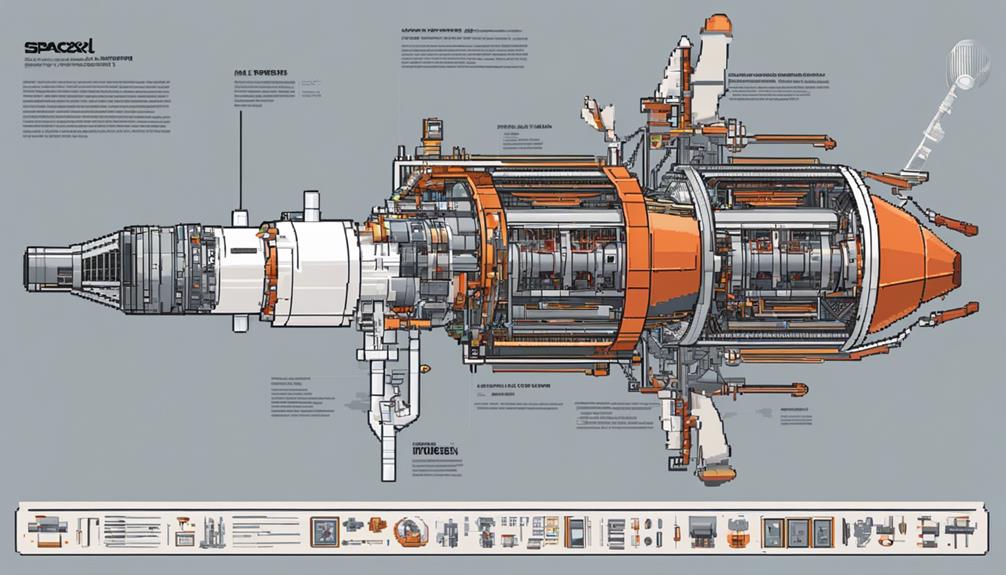The intricacies of the engineering feats behind SpaceX launches are a testament to the meticulous planning and technological prowess employed by the company. From the innovative design of the Starship and Super Heavy booster to the rigorous testing processes and material choices, every aspect is meticulously crafted to push the boundaries of space exploration. The continuous quest for improvement and the promise of future developments suggest that SpaceX's engineering endeavors are far from reaching their pinnacle, hinting at a future where space travel may become more accessible and efficient than ever before.
Key Takeaways
- SpaceX implements high-thrust Merlin and Raptor engines for efficient propulsion.
- Reusability of rocket components reduces costs and advances sustainability.
- Avionics, guidance systems, and advanced technology ensure precise mission control.
- Structural design with composite materials enhances strength and efficiency in SpaceX rockets.
Rocket Propulsion Systems

The intricate design and functionality of SpaceX's rocket propulsion systems exemplify cutting-edge engineering precision and innovation in the realm of space exploration. One of the key components of SpaceX's rocket propulsion systems is the Merlin engine. These engines, utilized in the Falcon 9 rocket, are known for their high thrust-to-weight ratios and regenerative cooling system. The Merlin engines play a crucial role in propelling the Falcon 9 rockets into orbit efficiently and effectively.
Additionally, SpaceX incorporates Raptor engines into its designs, which operate using methane and liquid oxygen. These advanced engines are specifically intended for future missions to Mars and other high-thrust applications, highlighting SpaceX's forward-thinking approach to rocket propulsion technology.
Moreover, the Falcon 9 rockets are equipped with nine Merlin engines at the base of the first stage, providing the necessary power for liftoff and initial ascent. The use of liquid oxygen as an oxidizer in these engines contributes to their high performance and reliability during launch sequences.
Furthermore, SpaceX's rockets are designed with landing legs that enable the first stage of the Falcon 9 to land vertically after completing its primary mission. This reusability feature is a testament to SpaceX's commitment to reducing the cost of space travel and making advancements in rocket engineering.
Reusability of Rocket Components
SpaceX's strategic emphasis on reusability underscores a pivotal shift in rocket engineering, particularly evident in the recovery and refurbishment of key components like the Falcon 9's first stage booster. The Falcon 9's first stage booster is a prime example of this reusability focus. Designed to land vertically after launch, it can undergo refurbishing processes to prepare for subsequent missions, significantly reducing the overall costs of space endeavors.
| Component | Purpose | Benefits |
|---|---|---|
| First Stage | Boosts rocket off Earth | Enables multiple launches |
| Booster Engines | Provide thrust | Extends operational lifespan |
| Refurbishing | Prepare for reflight | Cost-effective and sustainable solution |
Reusing rocket components like the first stage and refurbishing critical elements such as the booster engines and landing legs not only reduces expenses but also contributes to the sustainability of space missions. By extending the operational life of these components, SpaceX is at the forefront of revolutionizing the space industry. The cost-effective nature of reusability aligns with SpaceX's vision of making space more accessible and driving innovation in rocket engineering.
Avionics and Guidance Systems

Incorporating cutting-edge technology and precision engineering, avionics and guidance systems are integral components of SpaceX's rocket launches, ensuring precise control and mission success. SpaceX's avionics systems consist of sophisticated flight computers, sensors, and communication systems that play a pivotal role in guiding the rocket's trajectory from launch to landing. These systems are designed to monitor critical parameters, adjust the rocket's path, control engine burns, and enable precise landing maneuvers.
The guidance systems employed by SpaceX utilize a combination of GPS, inertial measurement units, and various sensors to accurately determine the rocket's position and orientation in real-time. By constantly analyzing and adjusting the rocket's flight path, these systems ensure that the vehicle stays on course and maneuvers as intended throughout the mission.
Avionics and guidance systems work in tandem to facilitate the safe and successful execution of SpaceX launches, contributing significantly to the reliability, accuracy, and overall safety of each mission. Through the seamless integration of advanced technologies and meticulous engineering, SpaceX showcases the importance of these systems in achieving optimal performance and mission outcomes in the realm of space exploration.
Structural Design and Materials
The selection process for materials in aerospace applications, such as SpaceX's Starship, involves meticulous consideration of factors like strength-to-weight ratio and thermal properties. Structural load analysis plays a critical role in ensuring components can withstand the forces experienced during launch, re-entry, and landing. Additionally, the utilization of composite materials offers advantages in weight reduction and enhanced structural performance, influencing the overall design and mission capabilities of spacecraft like the Starship.
Materials Selection Process
When engineering spacecraft like the Starship, the selection of materials for structural design plays a crucial role in ensuring optimal performance and durability in space missions. SpaceX's Starship utilizes stainless steel for its structural components, a strategic choice driven by cost-efficiency and durability in space's harsh conditions. This decision favored stainless steel over carbon fiber to streamline manufacturing processes and reduce costs. The material selection process for Starship emphasized factors such as strength-to-weight ratio, thermal properties, and reusability to meet the demands of space travel. Stainless steel's high melting point and corrosion resistance make it an ideal choice for Starship's re-entry and landing scenarios, showcasing SpaceX's commitment to innovative yet practical material choices for space exploration.
Structural Load Analysis
Utilizing advanced software simulations, engineers meticulously analyze the structural loads experienced by SpaceX rockets during flight and landing to ensure optimal performance and safety. This process involves:
- Calculating the various forces and stresses acting on different components of the rocket throughout its mission, including liftoff, flight, and re-entry.
- Utilizing material selection strategies, such as choosing stainless steel and carbon fiber, to enhance the rocket's ability to withstand the predicted loads and stresses.
- Considering dynamic loads, like atmospheric forces and re-entry impacts, to make informed design decisions that account for the complex interactions between the rocket and its environment.
Composite Material Utilization
Incorporating advanced composite materials like carbon fiber and titanium alloys is a fundamental aspect of SpaceX's rocket structural design and materials strategy. These composite materials offer a superior strength-to-weight ratio, enhancing structural integrity while enabling significant weight savings in SpaceX's rockets. Carbon fiber composites play a vital role in components such as fairings, interstages, and landing legs, providing durability against the extreme conditions experienced during launch and re-entry phases. On the other hand, titanium alloys are strategically utilized for critical parts like grid fins and engine components, offering exceptional strength while keeping the overall weight of the rocket at an optimum level. Through the strategic use of composite materials, SpaceX achieves a balance between structural design, performance, and weight efficiency for successful and efficient launches.
Ground Support Equipment Innovations
Ground support equipment innovations play a crucial role in optimizing SpaceX's launch operations by facilitating efficient rocket transportation and reusability. SpaceX's ground support equipment includes the Transporter Erector, a key component that aids in the movement of rockets from the hangar to the launch pad. The Transporter Erector not only transports the rockets but also provides a stable platform for the vertical integration of the rocket and payload, ensuring precise alignment before launch. This innovative equipment streamlines the pre-launch process, saving valuable time and resources.
Furthermore, SpaceX's Autonomous Spaceport Drone Ship serves as a groundbreaking landing platform for rocket boosters returning from space. By utilizing this drone ship, SpaceX can successfully recover and reuse rocket boosters, reducing the overall costs of launches. This technology represents a significant advancement in the quest for sustainable space travel practices.
In addition, SpaceX leverages state-of-the-art technology in its ground support equipment, enhancing launch operations and promoting reusability. These innovations not only improve the efficiency of SpaceX's missions but also contribute to the company's overarching goal of making space travel more accessible and cost-effective.
Payload Integration and Deployment

Payload integration and deployment in SpaceX launches entail meticulous procedures to securely house and safeguard the payload within the rocket's fairing. Engineers at SpaceX meticulously align and shield the payload to ensure its protection throughout the launch sequence. The deployment mechanisms employed by SpaceX are designed with precision to accurately release the payload into its target orbit.
Payload Handling Techniques
Vertical integration is a key aspect of SpaceX's payload handling techniques, ensuring precise alignment and attachment of payloads to the rocket for successful launch and deployment.
- Alignment Precision: SpaceX meticulously aligns and attaches payloads to the rocket, guaranteeing that they are properly positioned for launch and deployment.
- Safety Measures: Stringent safety protocols are followed during payload integration to safeguard both the payload and the rocket.
- Efficiency Optimization: SpaceX's integration processes are optimized for efficiency, streamlining the handling of payloads to meet tight launch schedules.
Deployment Mechanism Overview
Upon reaching the designated orbit, SpaceX's deployment mechanism initiates the precise release of satellites or cargo into space. SpaceX employs a payload fairing to shield satellites and payloads during launch and ascent. This fairing is discarded once the rocket exits the atmosphere, exposing the payload to space. Prior to launch, payloads are carefully integrated into the fairing at the launch site and then affixed to the rocket. The meticulous payload integration process guarantees accurate positioning and secure attachment, ensuring successful deployment. Once the rocket reaches its intended orbit, the payload deployment mechanism activates, facilitating the release of the satellite or cargo into its designated orbital trajectory. SpaceX's deployment mechanism plays a critical role in the successful deployment of payloads into space.
Continuous Improvement and Future Developments
In the realm of SpaceX's engineering endeavors, a relentless pursuit of continuous improvement and future developments propels the company towards unparalleled advancements in space exploration technology.
Key Developments:
- Enhanced Reusability: SpaceX is focusing on enhancing the reusability of its Falcon 9 launch vehicles to reduce costs and increase the frequency of space missions. By fine-tuning landing procedures and refurbishment processes, the company aims to make space travel more sustainable and economically viable.
- Advanced Propulsion Systems: The evolution of Merlin engines plays a crucial role in SpaceX's future developments. By optimizing engine performance, SpaceX aims to increase payload capacities, achieve higher velocities, and enable missions to distant destinations within our solar system efficiently.
- Innovative Manufacturing Processes: Continuous improvement efforts extend to manufacturing processes, where SpaceX is working on streamlining production lines, implementing automation technologies, and exploring novel materials to enhance the structural integrity and performance of their rockets. These advancements not only improve efficiency but also contribute to the development of next-generation spacecraft for ambitious space exploration endeavors.
Frequently Asked Questions
What Kind of Engineers Work at Spacex?
Engineers at SpaceX encompass various disciplines, including aerospace, mechanical, electrical, software, and materials engineering. These professionals specialize in structural analysis, propulsion systems, avionics integration, launch vehicle design, mission planning, and astronaut training. Their collaborative efforts drive innovation in space technology, enabling SpaceX to tackle the complexities of space exploration, reusability, and interplanetary travel. This diverse team plays a crucial role in all aspects of rocket development, from design to launch operations.
Who Designed the Spacex Rocket?
The SpaceX rocket designer, Elon Musk, is renowned for his innovative designs that have revolutionized aerospace technology. His engineering marvels in rocket propulsion have pushed the boundaries of space exploration. Incorporating cutting-edge rocket construction techniques, Musk's designs prioritize reusability and performance. Musk's vision and expertise have propelled SpaceX to the forefront of the space industry, setting new standards for rocket design and engineering excellence.
Who Is the Lead Aerospace Engineer at Spacex?
The lead aerospace engineer at SpaceX is crucial to the company's aerospace innovations and space exploration efforts. Responsible for overseeing rocket technology, launch vehicle advancements, and implementing cutting-edge aerospace engineering expertise, the lead engineer plays a pivotal role in the success of SpaceX missions. Their expertise in rocket propulsion techniques is instrumental in ensuring the efficiency and reliability of SpaceX's launches, contributing to the company's standing in the aerospace industry.
What Engines Are Used in Spacex Launch?
In rocket propulsion, SpaceX employs a range of engines known for their innovative thrust technology, fuel efficiency, and advanced combustion chambers. These engines, including Merlin, Kestrel, Draco, SuperDraco, and Raptor, are meticulously designed and undergo rigorous performance testing to ensure optimal functionality. Each engine type serves specific purposes within SpaceX's launch vehicles, contributing to the company's success in achieving reliable and efficient space missions.
